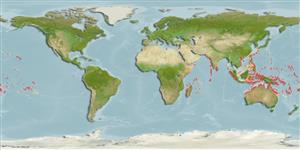Common names from other countries
>
Gobiiformes (Gobies) >
Gobiidae (Gobies) > Sicydiinae
Etymology: Sicyopterus: Greek, sika, sikya = cucumber + Greek, pteron = wing, fin (Ref. 45335).
More on author: Pallas.
Environment: milieu / climate zone / depth range / distribution range
Sinh thái học
Biển; Nước ngọt; Thuộc về nước lợ gần đáy; sống cả ở nước ngọt và nuớc mặn (Ref. 48660); Mức độ sâu 0 - 5 m (Ref. 86942). Tropical; 42°N - 26°S, 42°E - 128°W
Indo-Pacific: Comoros Islands (East Africa) to Australs Island (French Polynesia) (Ref. 77107). In the Indian Ocean, from Comoros to Mascarene Is. and in the Pacific Ocean, from Japan to French Polynesia, New-Caledonia and Vanuatu (Ref. 87781).
Length at first maturity / Bộ gần gũi / Khối lượng (Trọng lượng) / Age
Maturity: Lm 4.1, range 4 - ? cm
Max length : 13.0 cm TL con đực/không giới tính; (Ref. 4343); 10.7 cm SL (female)
Short description
Khóa để định loại | Hình thái học | Sinh trắc học
Các tia vây lưng cứng (tổng cộng) : 6 - 7; Các vây lưng mềm (tổng cộng) : 9 - 10; Tia cứng vây hậu môn: 1; Tia mềm vây hậu môn: 10. Usually 11 unsegmented rays in second dorsal fin. Pectoral rays usually 19. Predorsal midline usually with 13-16 cycloid scales, anterior scales smaller than those posteriorly. Scales on flanks same size as those on caudal peduncle. Belly always with fairly large cycloid scales, about the same size as those on the caudal peduncle. Caudal fin with blackish or dusky horseshoe-shaped band close to margin, medial rays blackish or dusky (Ref. 37578).
Adults inhabit fast-flowing sections of clear rainforest streams over rocky bottoms (Ref. 44894). Hatching and larval stage occur at sea, postlarval stage to adult in freshwater (Ref. 4343, 79840). Commercial in Reunion, where they are caught during the few days when they return from sea to enter the rivers (Doug Fenner, pers. comm., 2002, Ref. 79840). Smallest gravid female reported 5.03 cm SL (Ref. 37578).
Females when ready to spawn wriggles under a loosely set stone. The eggs are spread into a flat mass as the fish holds fast to the under surface of a stone. The eggs are fastened to the stones by the gelatinous threads that cover them (Ref. 110258). The male ejects his milt on the mass of eggs (Ref. 110258).
Spawning occurs in freshwater afterwhich eggs and larvae are washed down by the river current into the sea and goes back up the river after a month or so (Ref. 110258). The embryo development occurs in freshwater and the larvae should migrate to saltwater a few days following hatching. The larvae are carried by current to the sea where they grow up to the juvenile stage ("bichique"). At this stage the alevins get to the rivers and start going upstream during the new moon. They can go up to waterfalls higher than 10 meters with the help of their sucker-disc, that they can colonize waters up to 800m altitude (Ref. 48660).
Maugé, L.A., 1986. Gobiidae. p. 358-388. In J. Daget, J.-P. Gosse and D.F.E. Thys van den Audenaerde (eds.) Check-list of the freshwater fishes of Africa (CLOFFA). ISNB, Brussels; MRAC, Tervuren; and ORSTOM, Paris. Vol. 2. (Ref. 4343)
IUCN Red List Status (Ref. 130435)
CITES (Ref. 128078)
Not Evaluated
Threat to humans
Harmless
Human uses
Các nghề cá: Tính thương mại
Các công cụ
Special reports
Download XML
Các nguồn internet
Estimates based on models
Preferred temperature (Ref.
115969): 25.6 - 28.5, mean 26.9 (based on 319 cells).
Phylogenetic diversity index (Ref.
82804): PD
50 = 0.5000 [Uniqueness, from 0.5 = low to 2.0 = high].
Bayesian length-weight: a=0.01122 (0.00514 - 0.02450), b=3.04 (2.87 - 3.21), in cm Total Length, based on all LWR estimates for this body shape (Ref.
93245).
Mức dinh dưỡng (Ref.
69278): 2.8 ±0.31 se; based on food items.
Thích nghi nhanh (Ref.
120179): Chiêù cao, thời gian nhân đôi của chủng quần tối thiểu là dưới 15 tháng (Fec=46,000).
Fishing Vulnerability (Ref.
59153): Low vulnerability (10 of 100).
